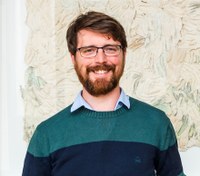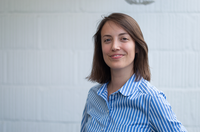Short talks | Biographies & abstracts
 Short talk #1 | Mathematics in support of decision-making | Dr Morgane Dumont (HEC - ULiège)
Short talk #1 | Mathematics in support of decision-making | Dr Morgane Dumont (HEC - ULiège)
After completing her PhD in mathematics at the University of Namur (UNamur), Morgane Dumont currently holds the position of Assistant Professor at the HEC - Management School of the University of Liège (ULiège).
Her research is predominantly applied, emphasizing the utilisation of mathematical and statistical tools for the examination of tangible scenarios. Notably, she has conducted research on spatial debris and synthetic populations, and has co-authored a book titled 'Spatial Microsimulation with R' alongside R. Lovelace.
Abstract: Decision making is a crucial but very difficult task, impacting potentially many individuals of a population. Whether it concerns health, transport, taxes or anything else, decisions and their consequences (both individual and collective) need to be seriously considered. Mathematical models can provide valuable assistance in this context. Several concrete applications will be exposed in this talk.
 Short talk #2 | Dr Sébastien Mouchet (University of Namur - University of Exeter)
Short talk #2 | Dr Sébastien Mouchet (University of Namur - University of Exeter)
Dr Sébastien R. Mouchet received his BSc, MSc and PhD degrees in Physics from the University of Namur, Belgium. Since his MSc and PhD degrees, he has studied the physical origins of various visual effects evolved by natural organisms: from additive colours in photonic polycrystals and fluid-induced colour changes to fluorescence emission in natural photonic structures and UV&IR scattering in integuments. Since the completion of his PhD degree in 2015, he has worked as a postdoctoral researcher at the University of Exeter, UK. In addition, he is now also working within the University of Namur, as a senior honorary lecturer and postdoctoral researcher.
In November 2023, he was awarded the 10th Charles Courtoy Prize for the best PhD thesis in Physics of UNamur for the period 2014-2017.
He co-founded bePOM (Belgium Photonics Online Meetup) conference series but stepped down from this committee after the 2023 conference.
Together with Prof. Olivier Deparis (University of Namur, NISM Institute, Department of Physics) he published a book "Natural photonics and bioinspiration" on the theme of physical optics and environmental biology. On the path of Jean-Pol Vigneron’s research, this “avant-garde” book according to Artech House, opens the door to bioinspired applications in the fields of optics, energy and the environment.
Abstract: Structurally coloured natural organisms exhibit complex optical devices leading to striking visual appearances. In insects, these devices are often made of biopolymers. A signature of the interference origin of such structural colours is iridescence, i.e. the displayed colours depend on the incidence and viewing angles. These colours are generally associated with structures such as photonic crystals. These structures are periodic along one, two or three dimensions. Such periodicities affect the propagation of electromagnetic waves inside the structured material through light interference. In addition to these optical effects, fluorescence emission can also occur due to the presence of fluorophores, which are naturally embedded within the structures’ materials. This phenomenon is termed controlled fluorescence. These optical phenomena are investigated by the so-called field of natural photonics.
In this contribution, we will provide an introduction to this field of research, through selected study cases from the class Insecta, namely structurally coloured dipterans and a fluorescent weevil.
Co-authors: Élise Camus, Marie M. Lobet, Olivier Deparis.
 Short talk #3 | How to evaluate camera calibration for sports videos? | Floriane Magera, Innovation Engineer at EVS Broadcast Equipment & PhD student (University of Liège)
Short talk #3 | How to evaluate camera calibration for sports videos? | Floriane Magera, Innovation Engineer at EVS Broadcast Equipment & PhD student (University of Liège)
Floriane Magera started as a civil engineer who steered herself into a computer science degree later. Currently, an Innovation Engineer at EVS Broadcast Equipment she is also pursuing her PhD degree at the University of Liege. She has worked on a variety of projects related to using deep learning and advanced computer vision techniques for augmenting live production. As of now, she is focusing on the automatic camera calibration of sports images using deep learning. She is part of SoccerNet, a scientific group maintaining datasets and organizing yearly competitions to stimulate research on sport image analysis.
Abstract: Camera calibration is a crucial component in the realm of sports analytics, as it serves as the foundation to extract 3D information out of the broadcast images. Precise camera calibration ensures that measurements such as player trajectories, ball movement, and game dynamics are captured with high fidelity, contributing to the precision of subsequent game analysis. However, despite its significance, the progress in camera calibration research for sports analytics is currently hindered by the outdated nature of the current evaluation criteria.
In this talk, we show how the nature of both metric and annotations of the current evaluation procedure is inadequate and how we can improve them.
 Short talk #4 | Photobiomodulation intervention before Radiotherapy of Triple-negative Breast Cancer in a Murine Model | Dr Camila Ramos (University of Namur)
Short talk #4 | Photobiomodulation intervention before Radiotherapy of Triple-negative Breast Cancer in a Murine Model | Dr Camila Ramos (University of Namur)
Dr Camila Ramos Silva holds a PhD from the University of São Paulo-Brazil and is currently a postdoctoral researcher at UNamur. Her research involves combining optical therapies with ionizing radiation to treat breast cancer. In recent years, she has also worked in scientific communication, developing, and presenting optical experiments.
Abstract: Radiotherapy is a well-established cancer treatment, however, some tumors, such as triple negative breast cancer (TNBC), may present as radioresistant and thus require high doses of ionizing radiation and a prolonged period of treatment, which can result in several side effects. Furthermore, such tumors show a high incidence of metastases and decrease the survival expectancy of the patient. Thus, new strategies for radiosensitizing TNBC are urgently needed. Red light therapy, photobiomodulation (PBM), has been used in clinical practice to mitigate the adverse side effects usually associated with radiotherapy. However, no studies have explored its use as a radiosensitizer for TNBC.
In this talk, some results will be share when PBM was associated with radiotherapy in a TNBC-bearing mice.
 Short talk #5 | Revolutionizing Cancer Treatment: Unleashing the Power of Gold Nanoparticles in a Symphony of Photothermal and Ultrasound Therapies | Dr Zahra Kayani (University of Namur)
Short talk #5 | Revolutionizing Cancer Treatment: Unleashing the Power of Gold Nanoparticles in a Symphony of Photothermal and Ultrasound Therapies | Dr Zahra Kayani (University of Namur)
Dr Zahra Kayani is a postdoctoral researcher in the field of Nanobiotechnology, having earned her Ph.D. from the Nanomedicine department at the University of Isfahan, Iran. Zahra's academic journey also includes a Bachelor's and Master's in Cellular & Molecular Biology.
Zahra specializes in designing and synthesizing various nanocarriers for cancer therapy. Her recent research has focused on advancing cancer therapy through the innovative use of smart nanocarriers, integrating them with sonodynamic, photothermal, and radiotherapy techniques. This reflects her dedication to pushing the boundaries of therapeutic strategies and making significant contributions to the field of nanotechnology in cancer treatment.
Abstract: In this comprehensive study, we navigate advanced non-invasive tumor treatment strategies by seamlessly integrating photothermal and ultrasound therapies with innovative photosensitizers and sonosensitizers. The synthesis of Curcumin-gold-polyethylene glycol nanoparticles (Cur-Au NPs-PEG) is a focal point, revealing their dual prowess in photothermal (PTT) and sonodynamic (SDT) therapies against melanoma. In vitro assessments unveil concentration-dependent cytotoxicity against B16/F10 cells, while in vivo studies underscore the superior efficacy of PTT and SDT in eradicating melanoma tumors. Expanding our exploration, gold nanoparticles coated by poly(ortho-aminophenol) (Au@POAP NPs) emerge as a novel sonosensitizer, showcasing efficient cell sonodynamic therapy (SDT) and inducing apoptosis or necrosis upon fractionated ultrasound irradiation for melanoma treatment. Furthermore, our investigation delves into nanobioconjugates, AuNCs-BSA, and Dox-AuNCs-BSA, designed as simultaneous duple photo/sonosensitizers and triune chemotherapeutics/photo/sonosensitizers for triple-negative breast cancer (TNBC). The study demonstrates efficient photothermal conversion and synergistic effects in CTX/PTT/SDT within MCF-7 and MDA-MB-231 breast cancer cell lines. These multifaceted strategies showcase promising potential, presenting advanced therapeutic options characterized by enhanced efficacy and the capacity to overcome resistance in cancer treatment.